National Union of Suffrage Societies
In 1865 a group of women in London formed a discussion group called the Kensington Society. Nine of the eleven women who attended the early meetings were unmarried and were attempting to pursue a career in education or medicine. The group eventually included Millicent Garrett, Elizabeth Garrett, Barbara Bodichon, Jessie Boucherett, Frances Power Cobbe, Emily Davies, Elizabeth Wolstenholme-Elmy, Francis Mary Buss, Dorothea Beale, Anne Clough and Sophia Jex-Blake (1)
It was given this name because they held their meetings at 44 Phillimore Gardens in Kensington. One of the founders of the group was Alice Westlake. On 18th March, Westlake wrote to Helen Taylor inviting her to join the group. She claimed that "none but intellectual women are admitted and therefore it is not likely to become a merely puerile and gossiping Society." (2) Westlake followed this with another letter a few days later: "There are very few few of the members whom you will know by name... the object of the Society is chiefly to serve as a sort of link, though a slight one, between persons, above the average of thoughtfulness and intelligence who are interested in common subjects, but who had not many opportunities of mutual intercourse." (3)
On 21st November 1865, the women discussed the topic of parliamentary reform. The question was: "Is the extension of the Parliamentary suffrage to women desirable, and if so, under what conditions?" Both Barbara Bodichon and Helen Taylor submitted a paper on the topic. The women thought it was unfair that women were not allowed to vote in parliamentary elections and in the debate that followed the resolution was passed by a large majority. (4)
Elizabeth Wolstenholme-Elmy, rarely attended meetings as she was based in Manchester. In October 1865, she decided to establish the Manchester Committee for the Enfranchisement of Women. She gained the support of local radical members of the Liberal Party that included Richard Pankhurst, Ursula Bright and Jacob Bright. Another important member was Lydia Becker who eventually became the leader of the group. Other people who joined over the next few years included Eva Maclaren, Esther Roper and Eva Gore-Booth. (5)
1867 Parliamentary Reform Act
In 1867 William Gladstone became leader of the Liberal Party. Gladstone made it clear that he was in favour of increasing the number of people who could vote. Although the Conservative Party had opposed previous attempts to introduce parliamentary reform, the new government were now sympathetic to the idea. The Conservatives knew that if the Liberals returned to power, Gladstone was certain to try again. Benjamin Disraeli "feared that merely negative and confrontational responses to the new forces in the political nation would drive them into the arms of the Liberals and promote further radicalism" and decided that the Conservative Party had to change its policy on parliamentary reform. (6)
On 20th May 1867, John Stuart Mill, proposed that women should be granted the same rights as men. "We talk of political revolutions, but we do not sufficiently attend to the fact that there has taken place around us a silent domestic revolution: women and men are, for the first time in history, really each other's companions... when men and women are really companions, if women are frivolous men will be frivolous... the two sexes must rise or sink together." (7)
During the debate on the issue, Edward Kent Karslake, the Conservative MP for Colchester, said in the debate that the main reason he opposed the measure was that he had not met one woman in Essex who agreed with women's suffrage. Lydia Becker, Helen Taylor and Frances Power Cobbe, decided to take up this challenge and devised the idea of collecting signatures in Colchester for a petition that Karslake could then present to parliament. They found 129 women resident in the town willing to sign the petition and on 25th July, 1867, Karslake presented the list to parliament. Despite this petition the Mill amendment was defeated by 196 votes to 73. Gladstone voted against the amendment. (8)
The 1867 Reform Act gave the vote to every male adult householder living in a borough constituency. Male lodgers paying £10 for unfurnished rooms were also granted the vote. This gave the vote to about 1,500,000 men. The Reform Act also dealt with constituencies and boroughs with less than 10,000 inhabitants lost one of their MPs. The forty-five seats left available were distributed by: (i) giving fifteen to towns which had never had an MP; (ii) giving one extra seat to some larger towns - Liverpool, Manchester, Birmingham and Leeds; (iii) creating a seat for the University of London; (iv) giving twenty-five seats to counties whose population had increased since 1832. (9)
Members of the Kensington Society were very disappointed when they heard the news and they decided to form the London Society for Women's Suffrage. Over the next few years Millicent Garrett Fawcett emerged as its most important member. She went on speaking tours on behalf of the women's movement. Her most popular lecture, Electoral Disabilities of Women attempted to deal with all the main objections to women having the vote. For example: (i) Women are sufficiently represented already by men, and their interests have always been jealously protected by the legislature. (ii) A woman is so easily influenced that if she had a vote it would practically have the same effect as giving two votes to her nearest male relation, or to her favourite clergyman. (iii) Women are so obstinate that if they had votes endless family discord would ensue. (iv) The ideal of domestic life is a miniature despotism - one supreme head, to whom all the other members of the family are subject. This ideal would be destroyed if the equality of women with men were recognised by extending the suffrage to women. (v) Women are intellectually inferior to men. (10)
During this period the very idea of a woman standing on a public platform was considered shocking. She found the experience difficult and although she always maintained an air of calm while on the platform, she professed not to enjoy this aspect of the work. Apparently she was so nervous before a speech that she was often physically ill. In an effort to cope with this problem she refused to speak either more than once a day or more than four times a week. (11)
Millicent Fawcett received a great deal of criticism for her public speaking. One man wrote: "I wish to observe that if you purchase a Bible and carefully read its teaching you will arrive at a better conclusion as to the intentions of the Great Creator as to the relation which should exist between the sexes than you will by reading the writings of J.S. Mill who seems to be the chief apostle of the woman suffrage question. I can only say that in my estimation no Christian woman who properly considered her sex and the Divine intention respecting her would take any direct part in politics." (12)
On 26th March, 1870, the London Society for Women's Suffrage, held a meeting on women's suffrage, in the Hanover Rooms on 26th March, 1870. Helen Taylor was the main speaker. Catherine Winkworth wrote later: "Miss Helen Taylor made a most remarkable speech. She is a slight young woman, with long, thin, delicate features, clear dark eyes and dark hair, which she wears in long bands on her cheeks, fashionably dressed in slight mourning; speaks off the platform in a high, thin voice, very shyly with an embarrassed air; on the platform she was really eloquent." Another observer, Kate Amberley commented that it was "a long and much studied speech; it was good but too like acting. Other speakers at the meeting included John Stuart Mill, Millicent Fawcett and Charles Wentworth Dilke. (13)
After John Stuart Mill lost his House of Commons seat, and Jacob Bright became leader of the suffragists in parliament, and took charge of the Women's Disabilities Removals Bill. In 1870 Bright and Sir Charles Wentworth Dilke introduced what was the first women's suffrage bill. In one speech Bright argued: "I know of no reason for the electoral disabilities of women. I know some reasons, which if there are to be electoral disabilities, would lead me to begin elsewhere than with women. Women are less criminal than men: they are more temperate than men the distinction is not small, it is broad and conspicuous; women are less vicious in their habits than men; they are more thrifty, more provident: they give more to the family, and take less to themselves." (14)
After its defeat Jacob Bright introduced another Women's Suffrage Bill in 1871. Once again, William Gladstone, the leader of the Liberal Party, arranged for it to be defeated and commented that women voting in elections would be "a practical evil of an intolerable character". (15)
Emmeline Pankhurst first became involved in the suffrage movement when she attended a meeting with her mother in 1872. It was hosted by veteran campaigner, Lydia Becker. "During the late 1860s Manchester also became the scene of one of the earliest campaigns for women's suffrage, and at fourteen Emmeline returned home from school one day to find her mother preparing to attend a suffrage meeting addressed by Lydia Becker in the city. Jane Pankhurst had no hesitation in agreeing to Emmeline, satchel in hand, accompanying her to hear the arguments." (16)
In November 1871, Jacob Bright suggested at the annual general meeting of the Manchester Society for Women's Suffrage that greater pressure could be applied on members of the House of Commons by establishing a Central Committee for Women's Suffrage in London. The first meeting of this new group was held on 17th January 1872. The first executive committee included Frances Power Cobbe, Agnes Garrett and Lilias Ashworth Hallett. Members of this new group included Millicent Garrett Fawcett, Florence Nightingale and Harriet Martineau. (17)
1884 Reform Act
The 1880 General Election was won by William Gladstone and the Liberal Party that had successfully obtained 352 seats with 54.7% of the vote. Queen Victoria and Gladstone were in constant conflict during his premiership. She often wrote to him complaining about his progressive policies. Victoria was especially opposed to parliamentary reform. In November, 1880, Queen Victoria she told him that he should be careful about making statements about future political policy: "The Queen is extremely anxious to point out to Mr. Gladstone the immense importance of the utmost caution on the part of all the Ministers but especially of himself, at the coming dinner in the City. There is such danger in every direction that a word too much might do irreparable mischief." (18)
In 1884 Gladstone introduced his proposals that would give working class males the same voting rights as those living in the boroughs. Gladstone told the House of Commons "that every Reform Bill had improved the House as a Representative Assembly". When opponents of the proposed bill cried "No, no!" Gladstone "insisted that whatever might be the effect on the House from some points of view, it was past doubt that the two Reform Acts had made the House far more adequate to express the wants and wishes of the nation as a whole". He added that when the House of Lords had blocked the Liberal's 1866 Reform Bill the following year "the Conservatives found it absolutely necessary to deal with the question, and so it would be again". (19)
Left-wing members of the Liberal Party, such as James Stuart, urged Gladstone to give the vote to women. Stuart wrote to Gladstone's daughter, Mary Gladstone Drew: "To make women more independent of men is, I am convinced, one of the great fundamental means of bringing about justice, morality, and happiness both for married and unmarried men and women. If all Parliament were like the three men you mention, would there be no need for women's votes? Yes, I think there would. There is only one perfectly just, perfectly understanding Being - and that is God.... No man is all-wise enough to select rightly - it is the people's voice thrust upon us, not elicited by us, that guides us rightly." (20)
Millicent Fawcett, on behalf of other female members of the Liberal Party, wrote a letter to Gladstone about this issue: "We write on behalf of more than a hundred women of liberal opinions, whose names we index, who are ready and anxious to take part in a deputation to you, to lay before you their strong conviction of the justice and propriety of granting some representation to women. Believing our own claim to be not only reasonable, but also in strict accord with the principle of your Bill, we are persuaded that if you are able to give any recognition to it, there is no act of your honourable career which will in the future be deemed more consistent with a truly liberal statesmanship." (21)
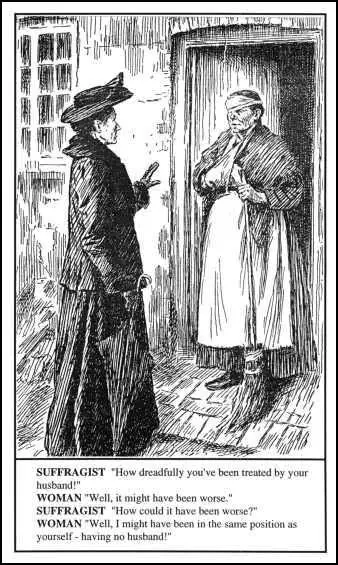
The following month, Edward Walter Hamilton, Gladstone's private secretary replied. "He (William Gladstone) is most unwilling to cause disappointment to yourself & your friends, whose title to be heard he fully recognises; and he can assure you that the difficulty of complying with a request so referred does not proceed from any want of appreciating the importance of your representation, or of the question itself. His fear is that any attempt to enlarge by material changes the provisions of the Franchise Bill now before Parliament might endanger the whole measure. For this reason, as well as on account of his physical inability at the present time to add to his engagements, he is afraid he must ask to be excused from acceding to your wishes." (22)
A total of 79 Liberal MPs asked Gladstone to recognize the claim of women's householders to the vote. Gladstone replied that if votes for women was included Parliament would reject the proposed bill: "The question with what subjects... we can afford to deal in and by the Franchise Bill is a question in regard to which the undivided responsibility rests with the Government, and cannot be devolved by them upon any section, however respected , of the House of Commons. They have introduced into the Bill as much as, in their opinion, it can safely carry." (23)
Gladstone authorized his Chief Whip to tell Liberal MPs that if the votes-for-women amendment were carried the bill would be dropped and the government would resign. He explained that "I am myself not strongly opposed to every form and degree of the proposal, but I think that if put into the Bill it would give the House of Lords a case for postponing it and I know not how to incur such a risk." (24)
Henry Fawcett was furious with Gladstone over this issue. As Fran Abrams, the author of Freedom's Cause: Lives of the Suffragettes (2003), has pointed out: "As a member of a government which opposed the measure he could not vote for it; as a keen supporter of reform he could not vote against it. In the end he abstained. The measure was roundly defeated but Gladstone was furious with Henry, and wrote to him saying his action had been tantamount to resignation. Henry was reprieved only because the Prime Minister wanted to avoid the bad publicity which would inevitably accompany a ministerial sacking." (25)
The House of Lords voted the Gladstone's Reform Bill down by 205 votes to 146. Eventually, Gladstone reached an agreement with the Lords. This time the Conservative members agreed to pass Gladstone's proposals in return for the promise that it would be followed by a Redistribution Bill. Gladstone accepted their terms and the 1884 Reform Act was allowed to become law. This measure gave the counties the same franchise as the boroughs - adult male householders and £10 lodgers - and added about six million to the total number who could vote in parliamentary elections. However, it did not give votes to women. (26)
National Union of Women's Suffrage Societies
In 1886, women in favour of women's suffrage in the party decided to form the Women's Liberal Federation. This group had no success in persuading the male leadership of the Liberal Party in parliament to support legislation. Suffragists within the party doubted the commitment of the leader of the organisation, Rosalind Howard, Countess of Carlisle, to the cause and in 1887 a group of women, including Millicent Garrett Fawcett, Eva Maclaren, Frances Balfour and Marie Corbett, formed the Liberal Women's Suffrage Society. (27)
By the 1890s there were seventeen individual groups that were advocating women's suffrage. This included the London Society for Women's Suffrage, Manchester Society for Women's Suffrage, Liberal Women's Suffrage Society and the Central Committee for Women's Suffrage. On 14th October 1897, these groups joined together to form the National Union of Women's Suffrage Societies (NUWSS). Millicent Fawcett was elected as president. Other members of the executive committee included Marie Corbett, Chrystal Macmillan, Maude Royden and Eleanor Rathbone. (28)
The NUWSS held public meetings, organised petitions, wrote letters to politicians, published newspapers and distributed free literature. The main demand was for the vote on the same terms "as it is, or may be" granted to men. It was thought that this proposal would be "more likely to find support than a broader measure that would put women into the electoral majority, and it might nevertheless play the part of the thin end of the wedge." Its message was directed at the Liberal Party, who it was hoped would win the next election. However, as one historian pointed out, the NUWSS's achilles heel was that it remained "irrationally optimistic about the Liberal Party". (29)
The Labour Party
On 27th February 1900, representatives of all the socialist groups in Britain (the Independent Labour Party (ILP), the Social Democratic Federation (SDF) and the Fabian Society, met with trade union leaders at the Congregational Memorial Hall in Farringdon Street. After a debate the 129 delegates decided to pass the motion proposed by Keir Hardie to establish "a distinct Labour group in Parliament, who shall have their own whips, and agree upon their policy, which must embrace a readiness to cooperate with any party which for the time being may be engaged in promoting legislation in the direct interests of labour." To make this possible the Conference established a Labour Representation Committee (LRC). (30)
Emmeline Pankhurst hoped the new Labour Party would support votes for women on the same terms as men. Although the party made it clear in its programme it favoured equal rights for men and women. Hardie argued for "the vote for women on the same terms as it is or may be granted to men". However, others in the party, including Isabella Ford, thought that as large number of working-class males did not have the vote, they should be demanding "full adult suffrage". Philip Snowden pointed out that if only middle-class women got the vote it would favour the Conservative Party. This was also the view of left-wing members of the Liberal Party such as David Lloyd George. (31)
In the 1902 Labour Party conference Emmeline Pankhurst created controversy when she proposed that "in order to improve the economic and social condition of women, it is necessary to take immediate steps to secure the granting of the suffrage to women on the same terms as it is, or may be, granted to men". This was not accepted and instead a resolution calling for "adult suffrage" became party policy.
Pankhurst's views on limited suffrage received a great deal of criticism. One of its leaders, John Bruce Glasier, had been a long-term supporter of universal suffrage, and like his wife, Katharine Glasier, was particularly opposed to Pankhurst's views. He recorded in his diary that he disapproved of her "individualist sexism". At a meeting with Emmeline and her daughter, Christabel Pankhurst, he claimed that the two women "were not seeking democratic freedom, but self-importance". (32) Trade union leader, Henry Snell, agreed: "Mrs. Pankhurst was magnetic, courageous, audacious, and resolute. Mrs. Pankhurst was an autocrat masquerading as a democrat". (33)
Women's Social and Political Union
After her defeat at conference, Emmeline Pankhurst decided to leave the Labour Party and decided to establish the Women's Social and Political Union (WSPU). Emmeline stated that the main aim of the organisation was to recruit working class women into the struggle for the vote. "We resolved to limit our membership exclusively to women, to keep ourselves absolutely free from ant party affiliation, and to be satisfied with nothing but action on our question. Deeds, not words, was to be our permanent motto." (34)
Some early members included Christabel Pankhurst, Sylvia Pankhurst, Adela Pankhurst, Emmeline Pethick-Lawrence, Marion Wallace-Dunlop, Elizabeth Robins, Flora Drummond, Annie Kenney, Mary Gawthorpe, May Billinghurst, Elizabeth Wolstenholme-Elmy, Mary Allen, Winifred Batho, Mary Leigh, Mary Richardson, Ethel Smyth, Teresa Billington-Greig, Helen Crawfurd, Emily Davison, Charlotte Despard, Mary Clarke, Margaret Haig Thomas, Cicely Hamilton, Eveline Haverfield, Edith How-Martyn, Constance Lytton, Kitty Marion, Dora Marsden, Hannah Mitchell, Margaret Nevinson, Evelyn Sharp, Nellie Martel, Helen Fraser, Minnie Baldock and Octavia Wilberforce.
The main objective was to gain, not universal suffrage, the vote for all women and men over a certain age, but votes for women, “on the same basis as men.” This meant winning the vote not for all women but for only the small stratum of women who could meet the property qualification. As one critic suggested, it was "not votes for women", but “votes for ladies.” As an early member of the WSPU, Dora Montefiore, pointed out: "The work of the Women’s Social and Political Union was begun by Mrs. Pankhurst in Manchester, and by a group of women in London who had revolted against the inertia and conventionalism which seemed to have fastened upon... the NUWSS." (35)
The forming of the WSPU upset both the National Union of Women's Suffrage Societies (NUWSS) and the Labour Party, the only party at the time that supported universal suffrage. They pointed out that in 1903 only a third of men had the vote in parliamentary elections. On the 16th December 1904, The Clarion published a letter from Ada Nield Chew, attacking WSPU policy: "The entire class of wealthy women would be enfranchised, that the great body of working women, married or single, would be voteless still, and that to give wealthy women a vote would mean that they, voting naturally in their own interests, would help to swamp the vote of the enlightened working man, who is trying to get Labour men into Parliament." (36)
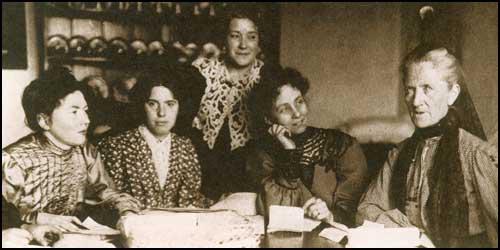
Nellie Martel, Emmeline Pankhurst and Charlotte Despard.
Teresa Billington Greig found Emmeline Pankhurst a difficult colleague: "To work alongside of her day by day was to run the risk of losing yourself. She was ruthless in using the followers she gathered around her, as she was ruthless to herself. She took advantage of both their strengths and their weaknesses suffered with you and for you while she believed she was shaping you and used every device of suppression when the revolt against the shaping came. She was a most astute statesman, a skilled politician, a self-dedicated reshaper of the world - and a dictator without mercy". (37)
On 16th and 17th October 1903, Elizabeth Wolstenholme-Elmy organized the National Convention for the Civil Rights of Women. The conference was sponsored by the NUWSS and held at the Holborn Town Hall. It was attended by 200 delegates, representing both the NUWSS and some other women's organizations such as the British Women's Temperance Association and the Women's Liberal Federation. At the convention Isabella Ford argued: "We want mass meetings in all the great towns of the U.K. - and as the local workers will seldom be rich enough personally to defray the costs, grants should be made towards the cost of these and of the many smaller meetings required to work them up." (38)
Elizabeth Crawford, the author of The Women's Suffrage Movement: A Reference Guide 1866-1928 (2000), has pointed out: "The NUWSS was instructed to form committees in every borough and country in order to press the question of women's suffrage, irrespective of party, upon every MP and candidate before the next general election and the local party associations should be pressured to select only candidates in favour of women's suffrage." (39)
1906 Liberal Government
In the 1906 General Election the Liberal Party won 399 seats and gave them a large majority over the Conservative Party (156) and the Labour Party (29). Fawcett hoped that Henry Campbell-Bannerman, the new prime minister, and his Liberal government, would give women the vote. However, several Liberal MPs were strongly against this. It was pointed out that there were a million more adult women than men in Britain. It was suggested that women would vote not as citizens but as women and would "swamp men with their votes". (40)
Campbell-Bannerman gave his personal support to Millicent Fawcett, though he warned her that he could not persuade his colleagues to support the legislation that would make their aspiration a reality. Despite the unwillingness of the Liberal government to introduce legislation, Fawcett remained committed to the use of constitutional methods to gain votes for women. (41)
Fawcett, like other members of the NUWSS, feared that the militant actions of the Women's Social and Political Union (WSPU) would alienate potential supporters of women's suffrage. However, Fawcett admired the courage of the suffragettes and was restrained in her criticism of the WSPU. In 1906 she joined with Lilias Ashworth Hallett in organizing the banquet at the Savoy to celebrate the release from Holloway Prison of WSPU prisoners. (42)
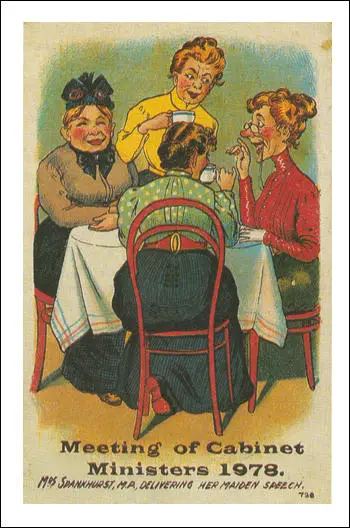
Millicent Fawcett's sister, Elizabeth Garrett Anderson and her daughter, Louisa Garrett Anderson, joined the WSPU. During this period she was willing to defend the actions of the suffragettes. She wrote to The Times, hoping "the more old-fashioned suffragists" would stand by the suffragettes, since in her opinion, "far from having injured the movement, they have done more during the last twelve months to bring it within the region of practical politics than we have been able to accomplish in the same number of years." (43)
In an attempt to persuade Henry Campbell-Bannerman and his government to give women the vote the NUWSS decided to hold its largest demonstration in its history. Organised by Philippa Strachey the United Procession of Women took place on 9th February 1907. It was a completely peaceful demonstration where more than three thousand women marched from Hyde Park Corner to the Strand in support of women's suffrage. It acquired the name "Mud March" from the day's weather, when incessant heavy rain left the marchers drenched and mud-spattered. (44)
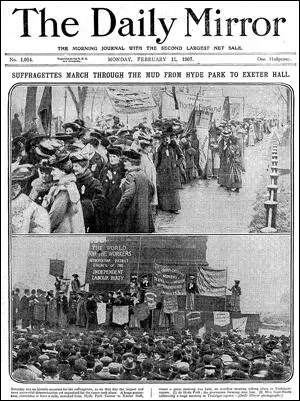
Henry Campbell-Bannerman resigned in April 1908 and was replaced by Herbert Asquith. He had always been hostile to the idea of women's suffrage and made it clear that his government would not introduce legislation to give women the vote. "He refused to see or hear anyone connected with the suffrage societies, and pretended to be unable to distinguish between those who were attacking him and his Party and those who were merely pressing their cause." (45)
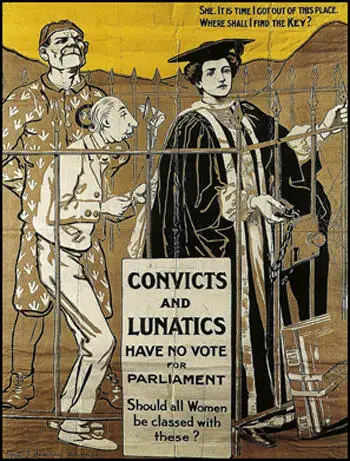
The NUWSS continued to grow. In May 1908 Catherine Marshall and her mother established a branch in Keswick. Catherine reported later: "A committee was formed, rules drawn up, and active propaganda work started at once. It was unanimously decided that our object should be votes for women on the same terms as for men, and that the Association should be a strictly non-party organization; we also pledged ourselves to peaceful and constitutional methods only. Our work was to consist of spreading the principles of Women's Suffrage by means of meetings, of Ietters to the press, of distributing literature on the subject.... The audience at these meetings averaged between 50 and 100 in numbers; in every instance a resolution in favour of votes for women on the same terms as for men was enthusiastically carried." (46)
Art and the NUWSS
Caroline Watts became a member of the NUWSS and the Artists' Suffrage League (ASL). In 1908 Watts produced The Bugler Girl to advertise the important June 1908 NUWSS procession. Elizabeth Crawford has pointed out: "The central figure in this, the 'Bugler Girl', is closely associated with the heroic images Caroline was creating for the books commissioned by David Nutt and in 1908 struck a suitably chivalric note." (47)
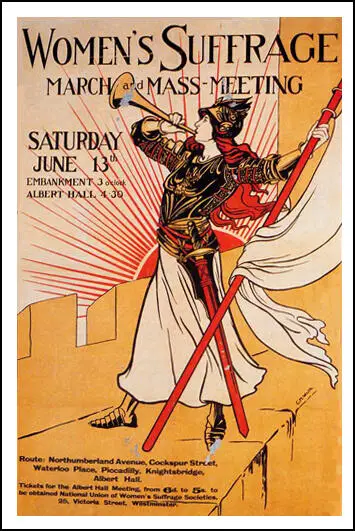
The image created by Watts appeared on NUWSS posters and pamphlets. It was also used on a badge given to NUWSS's paid organisers. However, by 1913, with Women's Social and Political Union (WSPU), militancy intensified, the NUWSS pointed out that it did not mean that it was a violent organisation. A member of the NUWSS governing-council argued in The Common Cause: "Our Bugler Girl carries her bugle and her banner; her sword is sheathed by her side; it is there, but not drawn, and if it were drawn, it would not be the sword of the flesh, but of the spirit. For ours is not a warfare against men, but against evil." (48)
Dora Meeson Coates was a founder member of the Artists' Suffrage League (ASL). In 1908 Coates entered a NUSS poster competition. According to the Women's Franchise newspaper she took first place beating her friend Emily Harding Andrews into joint second place. The judges commented that they found it impossible to decide on which was the better, Miss Williams's design being the more artistic, while Mrs Andrews' would reproduce better". (49)
Dora's poster shows "Mrs John Bull" holding an empty dish labelled "Votes for Women" while six boys - Primrose League, Trade Unions, Liberal Federation, Women's Liberal Association, Social Democratic Federation and Independent Labour Party - clamour for more soup from a large bowl labelled "Political Help". The mother says: "Now you greedy boys I shall not give you any more until I have helped myself." (50)
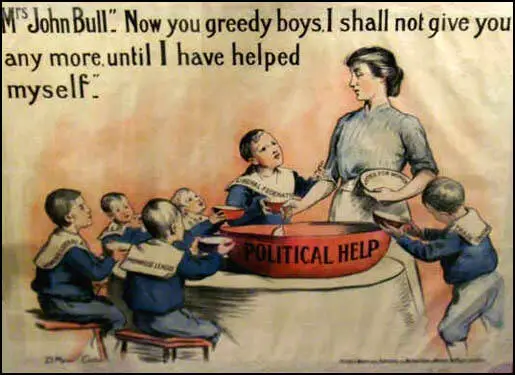
Dora also painted the 1908 London suffrage march union banner and designing posters and postcards to publicise similar marches. Dora worked with Cicely Hamilton and Mary Lowndes and contributed powerful line drawings to the Artists' Suffrage League publications Beware! A Warning to Suffragists (1909) and A.B.C. of Politics for Women Politicians (1910). (51)
Philippa Strachey, was secretary of the London Society for Women's Suffrage. Her cousin was the artist Duncan Grant who she encouraged him to became interested in the subject of women's suffrage and in 1909 Grant entered the Artists' Suffrage League (ASL) in association with the National Union of Suffrage Societies (NUWSS) poster competition. Grant submitted Handicapped! and shared the first prize of £5. (52)
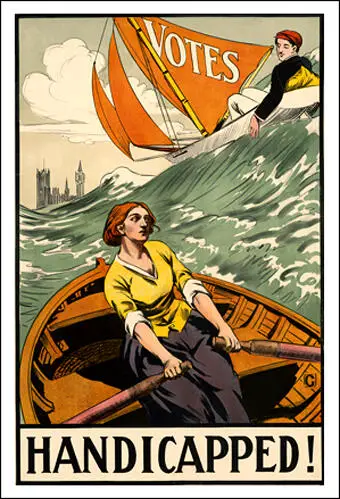
The Common Cause newspaper described it as depicting "a stalwart Grace Darling type struggling in the trough of a heavy sea with only a pair of sculls, while a nonchalant young man in flannels glides gaily by, with a wind inflating his sail - the vote - treating with good temper a subject which often causes bitterness." (53)
Anti-Suffrage Society
William Cremer was one of the leading opponents of women's suffrage. Hansard reported: "He (William Cremer) had always contended that if we opened the door and enfranchised ever so small a number of females, they could not possibly close it, and that it ultimately meant adult suffrage. The government of the country would therefore be handed over to a majority who would not be men, but women. Women are creatures of impulse and emotion and did not decide questions on the ground of reason as men did. He was sometimes described as a woman-hater, but he had had two wives, and he thought that was the best answer he could give to those who called him a woman-hater. He was too fond of them to drag them into the political arena and to ask them to undertake responsibilities, duties and obligations which they did not understand and did not care for." (54)
In the summer of 1908 the famous author, Mary Humphry Ward, was approached by William Cremer and asked to become the first president of the Anti-Suffrage League. Ward agreed and on 8th July, 1908 the organisation published its manifesto. It included the following: "It is time that the women who are opposed to the concession of the parliamentary franchise to women should make themselves fully and widely heard. The matter is urgent. Unless those who hold that the success of the women's suffrage movement would bring disaster upon England are prepared to take immediate and effective action, judgement may go by default and our country drift towards a momentous revolution, both social and political, before it has realised the dangers involved." (55)
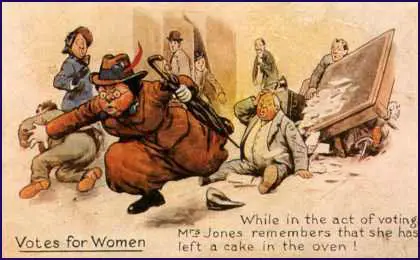
Mary Humphry Ward argued the case against women's suffrage at debates at Newnham College and Girton College. Once a role model for educated young women, she received a hostile reception from the students when she told them that the "emancipating process has now reached the limits fixed by the physical constitution of women". She recorded in her diary after the Girton debate that "the fire and the rage were immense" and blamed the staff who she accused of being "hotly suffrage".
Ward wrote in The Times: "Women's suffrage is a more dangerous leap in the dark than it was in the 1860s because of the vast growth of the Empire, the immense increase of England's imperial responsibilities, and therewith the increased complexity and risk of the problems which lie before our statesmen - constitutional, legal, financial, military, international problems - problems of men, only to be solved by the labour and special knowledge of men, and where the men who bear the burden ought to be left unhampered by the political inexperience of women". (56)
Mary Humphry Ward toured the country making speeches against women's suffrage. The Anti-Suffrage League collected signatures against women having the vote and at a meeting on 26th March, 1909, Ward announced that over 250,000 people had signed the petition. The following June she reported that the movement had 15,000 paying members and 110 branches and the number who had signed the petition had reached 320,000. (57)
The leaders of the Anti-Suffrage League claimed that the vast majority of women in Britain were not interested in having the vote and that there was a danger that a small group of organised women would force the government to change the electoral system. Lord Curzon, another strong opponent of women's suffrage, arranged for a delegation from the Anti-Suffrage League to meet Herbert Asquith, who agreed, that to grant women the vote would be "a political mistake of a very disastrous kind". (58)
The Conciliation Bill
The Common Cause was first published on 15th April 1909. Mainly financed by Margaret Ashton, it supported the policies of the National Union of Women's Suffrage Societies and in its first edition it stated that it was "the organ of the women's movement for reform". Helena Swanwick was the newspaper's first editor, at an annual salary of £200. Clementina Black and Maude Royden also had spells as editor. (59)
In 1909 David Lloyd George announced what became known as the People's Budget. This included increases in taxation. Whereas people on lower incomes were to pay 9d. in the pound, those on annual incomes of over £3,000 had to pay 1s. 2d. in the pound. Lloyd George also introduced a new supertax of 6d. in the pound for those earning £5000 a year. Other measures included an increase in death duties on the estates of the rich and heavy taxes on profits gained from the ownership and sale of property. Other innovations in Lloyd George's budget included labour exchanges and a children's allowance on income tax. (60)
The Conservative Party had a large majority in the House of Lords, strongly objected to this attempt to redistribute wealth, and made it clear that they intended to block these proposals. Lloyd George reacted by touring the country making speeches in working-class areas on behalf of the budget and portraying the nobility as men who were using their privileged position to stop the poor from receiving their old age pensions. After a long struggle with the House of Lords, Lloyd George finally got his budget through parliament. (61)
In January 1910, Asquith called a general election in order to obtain a new mandate. However, the Liberals lost votes and was forced to rely on the support of the 42 Labour Party MPs to govern. Henry Brailsford, a member of the Men's League For Women's Suffrage wrote to Millicent Fawcett, suggesting that he should attempt to establish a Conciliation Committee for Women's Suffrage. "My idea is that it should undertake the necessary diplomatic work of promoting an early settlement". (62)
Millicent Fawcett and Emmeline Pankhurst both agreed to the idea and the WSPU declared a truce in which all militant activities would cease until the fate of the Conciliation Bill was clear. A Conciliation Committee, composed of 36 MPs (25 Liberals, 17 Conservatives, 6 Labour and 6 Irish Nationalists) all in favour of some sort of women's enfranchisement, was formed and drafted a Bill which would have enfranchised only a million women but which would, they hoped, gain the support of all but the most dedicated anti-suffragists. (63) Fawcett wrote that "personally many suffragists would prefer a less restricted measure, but the immense importance and gain to our movement is getting the most effective of all the existing franchises thrown upon to woman cannot be exaggerated." (64)
The Conciliation Bill was designed to conciliate the suffragist movement by giving a limited number of women the vote, according to their property holdings and marital status. After a two-day debate in July 1910, the Conciliation Bill was carried by 109 votes and it was agreed to send it away to be amended by a House of Commons committee. However, before they completed the task, Asquith called another election in order to get a clear majority. However, the result was very similar and Asquith still had to rely on the support of the Labour Party to govern the country. (65)
A new Conciliation Bill was passed by the House of Commons on 5th May 1911 with a majority of 167. The main opposition came from Winston Churchill, the Home Secretary, who saw it as being "anti-democratic". He argued "Of the 18,000 women voters it is calculated that 90,000 are working women, earning their living. What about the other half? The basic principle of the Bill is to deny votes to those who are upon the whole the best of their sex. We are asked by the Bill to defend the proposition that a spinster of means living in the interest of man-made capital is to have a vote, and the working man's wife is to be denied a vote even if she is a wage-earner and a wife." (66)
David Lloyd George, the Chancellor of the Exchequer, was officially in favour of woman's suffrage. However, he had told his close associates, such as Charles Masterman, the Liberal MP in West Ham North: "He (David Lloyd George) was very much disturbed about the Conciliation Bill, of which he highly disapproved although he is a universal suffragist... We had promised a week (or more) for its full discussion. Again and again he cursed that promise. He could not see how we could get out of it, yet he regarded it as fatal (if passed)." (67)
Lloyd George was convinced that the chief effect of the Bill, if it became law, would be to hand more votes to the Conservative Party. During the debate on the Conciliation Bill he stated that justice and political necessity argued against enfranchising women of property but denying the vote to the working class. The following day Herbert Asquith announced that in the next session of Parliament he would introduce a Bill to enfranchise the four million men currently excluded from voting and suggested it could be amended to include women. Paul Foot has pointed out that as the Tories were against universal suffrage, the new Bill "smashed the fragile alliance between pro-suffrage Liberals and Tories that had been built on the Conciliation Bill." (68)
Millicent Fawcett still believed in the good faith of the Asquith government. However, the WSPU, reacted very differently: "Emmeline and Christabel Pankhurst had invested a good deal of capital in the Conciliation Bill and had prepared themselves for the triumph which a women-only bill would entail. A general reform bill would have deprived them of some, at least, of the glory, for even though it seemed likely to give the vote to far more women, this was incidental to its main purpose." (69)
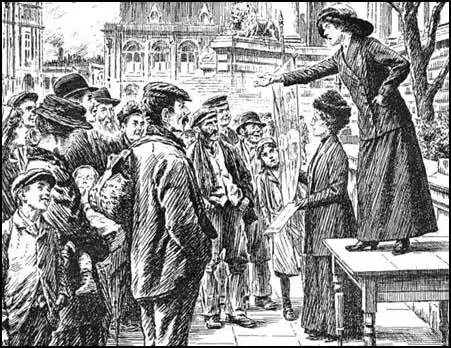
Christabel Pankhurst wrote in Votes for Women that Lloyd George's proposal to give votes to seven million instead of one million women was, she said, intended "not, as he professes, to secure to women a larger measure of enfranchisement but to prevent women from having the vote at all" because it would be impossible to get the legislation passed by Parliament. (70)
On 21st November, the WSPU carried out an "official" window smash along Whitehall and Fleet Street. This involved the offices of the Daily Mail and the Daily News and the official residences or homes of leading Liberal politicians, Herbert Asquith, David Lloyd George, Winston Churchill, Edward Grey, John Burns and Lewis Harcourt. It was reported that "160 suffragettes were arrested, but all except those charged with window-breaking or assault were discharged." (71)
The following month Millicent Fawcett wrote to her sister, Elizabeth Garrett: "We have the best chance of Women's Suffrage next session that we have ever had, by far, if it is not destroyed by disgusting masses of people by revolutionary violence." Elizabeth agreed and replied: "I am quite with you about the WSPU. I think they are quite wrong. I wrote to Miss Pankhurst... I have now told her I can go no more with them." (72)
Henry Brailsford went to see the Emmeline Pankhurst and asked her to control her members in order to get the legislation passed by Parliament. She replied "I wish I had never heard of that abominable Conciliation Bill!" and Christabel Pankhurst called for more militant actions. The Conciliation Bill was debated in March 1912, and was defeated by 14 votes. Asquith claimed that the reason why his government did not back the issue was because they were committed to a full franchise reform bill. However, he never kept his promise and a new bill never appeared before Parliament. (73)
Ray Strachey, the author of The Cause: A History of the Women's Movement in Great Britain (1928) pointed out that Millicent Fawcett now lost complete confidence in the Liberal Party to give women the vote: "Nothing more was ever hoped for the Liberal Party. The only prospect of successful lay in a change of Government, and to this end the women now devoted their energies." (74)
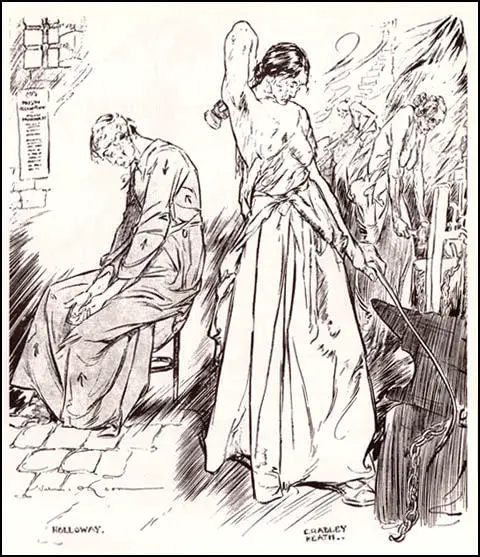
UNWOMANLY (Holloway) WOMANLY (Cradley Heath)
In early 1912 Millicent Fawcett and the NUWSS took the decision to form an electoral alliance with the growing Labour Party, as the only political party which really supported women's suffrage. "It soon strengthened that alliance, setting up a special Election Fighting Fund in May-June so that the NUWSS could help Labour candidates more effectively at by-elections." (75)
In March 1912 the WSPU organised a new campaign that involved the large-scale smashing of shop-windows. Her niece, Louisa Garrett Anderson, was arrested during this demonstration and was sentenced to six weeks in Holloway Prison. Millicent Fawcett was upset when she heard the news and wrote to her sister, Elizabeth Garrett Anderson: "I am in hopes she will take her punishment wisely, that the enforced solitude will help her to see more in focus than she always does." (76)
Election Fighting Fund
The Conciliation Bill was debated in March 1912, and was defeated by 14 votes. Herbert Asquith claimed that the reason why his government did not back the issue was because they were committed to a full franchise reform bill. However, he never kept his promise and a new bill never appeared before Parliament. (77)
Ray Strachey, the author of The Cause: A History of the Women's Movement in Great Britain (1928) pointed out that Millicent Garrett Fawcett now lost complete confidence in the Liberal Party to give women the vote: "Nothing more was ever hoped for the Liberal Party. The only prospect of successful lay in a change of Government, and to this end the women now devoted their energies." (78)
In early 1912 Millicent Garrett Fawcett and the NUWSS took the decision to form an electoral alliance with the growing Labour Party, as it was the only political party which really supported women's suffrage. "It soon strengthened that alliance, setting up a special Election Fighting Fund (EFF) in May-June so that the NUWSS could help Labour candidates more effectively at by-elections." (79)
A committee was formed to ensure the success of the EFF. Members included Catherine Marshall, Isabella Ford, Margaret Ashton, Kathleen Courtney, Muriel de la Warr, Margory Lees and Ethel Annakin Snowden. In 1913–14 the EFF intervened in four by-elections and although Labour won none, the governing Liberal Party lost two seats. (80)
Women's Suffrage Pilgrimage
Although the NUWSS failed to achieve success in its various campaigns to win the vote, it continued to gain support. The extra publicity it had received, increased membership from 13,429 in 1909 to 21,571 to 1910. It now had 207 societies and its income had reached £14,000. It was decided to restructure the NUWSS into federations. By 1911 the NUWSS now had 16 federations and 26,000 members. The NUWSS now had enough funds to appoint Catherine Marshall and Kathleen Courtney to full-time posts at national headquarters.
In 1913 Katherine Harley, a senior figure in the NUWSS, suggested holding a Woman's Suffrage Pilgrimage in order to show Parliament how many women wanted the vote. According to Lisa Tickner, the author of The Spectacle of Women (1987) argued: "A pilgrimage refused the thrill attendant on women's militancy, no matter how strongly the militancy was denounced, but it also refused the glamour of an orchestrated spectacle." (81)
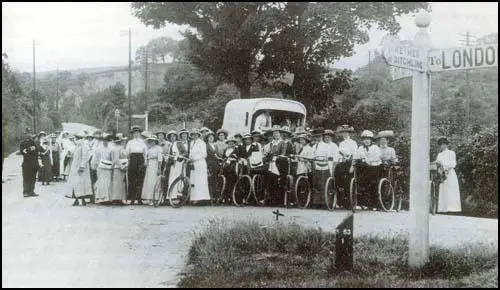
Members of the NUWSS set off on 18th June, 1913. According to Elizabeth Crawford, the author of The Suffragette Movement (1999): "Pilgrims were urged to wear a uniform, a concept always close to Katherine Harley's heart. It was suggested that pilgrims should wear white, grey, black, or navy blue coats and skirts or dresses. Blouses were either to match the skirt or to be white. Hats were to be simple, and only black, white, grey, or navy blue. For 3d, headquarters supplied a compulsory raffia badge, a cockle shell, the traditional symbol of pilgrimage, to be worn pinned to the hat. Also available were a red, white and green shoulder sash, a haversack, made of bright red waterproof cloth edged with green with white lettering spelling out the route travelled, and umbrellas in green or white, or red cotton covers to co-ordinate civilian umbrellas." (82)
Members of the NUWSS publicized the Women's Pilgrimage in local newspapers. Helen Hoare, for example, sent a letter to The East Grinstead Observer: "It is no doubt true that some men were formerly inclined to support it have been alienated by the doings of the militant party. The National Union of Women’s Suffrage Society (that is the law-abiding, non-militant party), in order to show the world that it is alive, and to encourage its members in a long and disheartening struggle, has organised a great pilgrimage from all parts of England to London." (83)
Millicent Garrett Fawcett, now aged 66 years old, took a very active part in the pilgrimage, walking with the East Anglican pilgrims between speaking engagements and the other routes. An estimated 50,000 women reached Hyde Park in London on 26th July. Fawcett was the main speaker and she made it clear that she dissociated herself with the tactics of the Women Social & Political Union. (84)
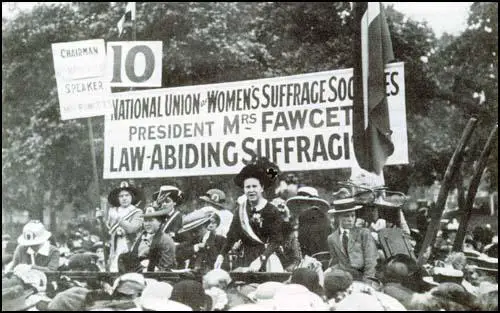
culmination of the Pilgrimage on 26th July 1913.
As The Times newspaper pointed out, the march was part of a campaign against the violent methods being used by the WSPU: "On Saturday the pilgrimage of the law abiding advocates of votes for women ended in a great gathering in Hyde Park attended by some 50,000 persons. The proceedings were quite orderly and devoid of any untoward incident. The proceedings, indeed, were as much a demonstration against militancy as one in favour of women's suffrage. Many bitter things were said of the militant women." (85)
Millicent Fawcett wrote to Herbert Asquith "on behalf of the immense meetings which assembled in Hyde Park on Saturday and voted with practical unanimity in favour of a Government measure." (86) Asquith replied that the demonstration had "a special claim" on his consideration and stood "upon another footing from similar demands proceeding from other quarters where a different method and spirit is predominant." A meeting was held and afterwards commented that she felt that there had been "a notable improvement in his attitude and language". (87)
The First World War
With growing political tension growing between Britain and Germany, Millicent Garrett Fawcett issued a statement on behalf of the International Woman Suffrage Alliance. "We, the women of the world, view with apprehension and dismay the present situation in Europe, which threatens to involve one continent, if not the whole world, in the disasters and horrors of war... We women of twenty-six countries, having bonded ourselves together in the International Woman Suffrage Alliance with the object of obtaining the political means of sharing with men the power which shapes the fate of nations, appeal to you to leave untried no method of conciliation or arbitration for arranging international differences to avert deluging half the civilised world in blood." (88)
Two days after the British government declared war on Germany on 4th August 1914, the NUWSS declared that it was suspending all political activity until the conflict was over. That night Millicent Fawcett chaired a meeting against the war. Speakers included Helena Swanwick, Olive Schreiner, Mary Macarthur, Mabel Stobart and Elizabeth Cadbury. Fawcett said there were millions of women who thought that was was a "crime against society". She added: "A way must be found out of the tangle... In the first place they should try and avoid bitterness of national feeling. They should on the one hand keep down panic and on the other the war fever and Jingo feeling." (89)
Although Fawcett supported the war effort she refused to become involved in persuading young men to join the armed forces. This WSPU took a different view to the war. It was a spent force with very few active members. According to Martin Pugh, the WSPU were aware "that their campaign had been no more successful in winning the vote than that of the non-militants whom they so freely derided". (90)
The WSPU carried out secret negotiations with the government and on the 10th August the government announced it was releasing all suffragettes from prison. In return, the WSPU agreed to end their militant activities and help the war effort. Christabel Pankhurst, arrived back in England after living in exile in Paris. She told the press: "I feel that my duty lies in England now, and I have come back. The British citizenship for which we suffragettes have been fighting is now in jeopardy." (91)
After receiving a £2,000 grant from the government, the WSPU organised a demonstration in London. Members carried banners with slogans such as "We Demand the Right to Serve", "For Men Must Fight and Women Must Work" and "Let None Be Kaiser's Cat's Paws". At the meeting, attended by 30,000 people, Emmeline Pankhurst called on trade unions to let women work in those industries traditionally dominated by men. She told the audience: "What would be the good of a vote without a country to vote in!". (92)
Despite pressure from some members of the NUWSS, Fawcett refused to argue against the First World War. At a Council meeting of the National Union of Women's Suffrage Societies held in February 1915, Fawcett attacked the peace efforts of people like Mary Sheepshanks. Fawcett argued that until the German armies had been driven out of France and Belgium: "I believe it is akin to treason to talk of peace." Her biographer, Ray Strachey, argued: "She stood like a rock in their path, opposing herself with all the great weight of her personal popularity and prestige to their use of the machinery and name of the union." (93)
After a stormy executive meeting in Buxton in 1915 all the officers of the NUWSS (except the Treasurer) and ten members of the National Executive resigned over the decision not to support the Women's Peace Congress at the Hague. This included Chrystal Macmillan, Margaret Ashton, Kathleen Courtney, Catherine Marshall, Eleanor Rathbone and Maude Royden. "Wounding language was used on both sides. Mrs Fawcett did not normally turn disagreements among friends into quarrels but this one she experienced as a personal betrayal. It became the only episode in her life that she wished to forget". (94)
Kathleen Courtney wrote when she resigned: "I feel strongly that the most important thing at the present moment is to work, if possible on international lines for the right sort of peace settlement after the war. If I could have done this through the National Union, I need hardly say how infinitely I would have preferred it and for the sake of doing so I would gladly have sacrificed a good deal. But the Council made it quite clear that they did not wish the union to work in that way." According to Elizabeth Crawford: "Mrs Fawcett afterwards felt particularly bitter towards Kathleen Courtney, whom she felt had been intentionally and personally wounding, and refused to effect any reconciliation, relying, as she said, on time to erase the memory of this difficult period." (95)
In May 1916 Millicent Fawcett wrote to Herbert Asquith that women deserved the vote for their war efforts. In August he told the House of Commons that he had now changed his mind and that he intended to introduce legislation that would give women the vote. On 28th March, 1917, the House of Commons voted 341 to 62 that women over the age of 30 who were householders, the wives of householders, occupiers of property with an annual rent of £5 or graduates of British universities. MPs rejected the idea of granting the vote to women on the same terms as men. Lilian Lenton, who had played an important role in the militant campaign later recalled: "Personally, I didn't vote for a long time, because I hadn't either a husband or furniture, although I was over 30." (96)
The Qualification of Women Act was passed in February, 1918. The Manchester Guardian reported: "The Representation of the People Bill, which doubles the electorate, giving the Parliamentary vote to about six million women and placing soldiers and sailors over 19 on the register (with a proxy vote for those on service abroad), simplifies the registration system, greatly reduces the cost of elections, and provides that they shall all take place on one day, and by a redistribution of seats tends to give a vote the same value everywhere, passed both Houses yesterday and received the Royal assent." (97)
The First World War ended in November 1918. Millicent Fawcett lost "no fewer than twenty-nine members of her extended family, including two nephews" in the war. Whereas the WSPU "were prepared to accept votes for women on any terms the government had to offer... the NUWSS continued to press its old case for equality with men". She was urged to stand for Parliament in the 1918 General Election, but aged seventy-one, she decided to retire from politics. (98)
On the resignation of Millicent Garrett Fawcett in 1919, Eleanor Rathbone became president of the NUWSS. A new organisation called the National Union of Societies for Equal Citizenship was established. Later that year Rathbone persuaded the organization to accept a six point reform programme. (i) Equal pay for equal work, involving an open field for women in industry and the professions. (ii) An equal standard of sex morals as between men and women, involving a reform of the existing divorce law which condoned adultery by the husband, as well as reform of the laws dealing with solicitation and prostitution. (iii) The introduction of legislation to provide pensions for civilian widows with dependent children. (iv) The equalization of the franchise and the return to Parliament of women candidates pledged to the equality programme. (v) The legal recognition of mothers as equal guardians with fathers of their children. (vi) The opening of the legal profession and the magistracy to women. (99)

